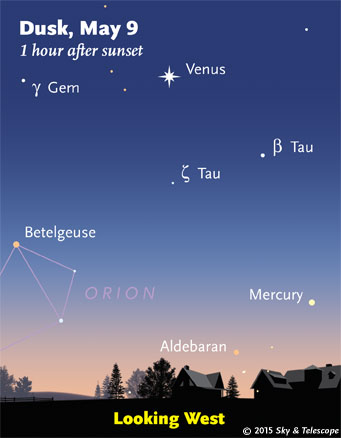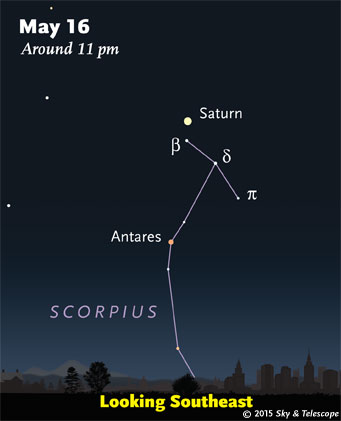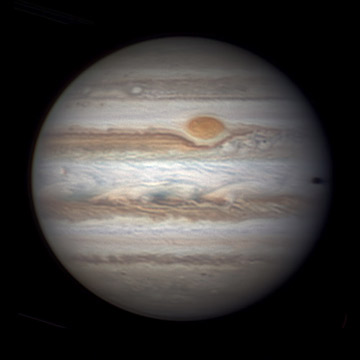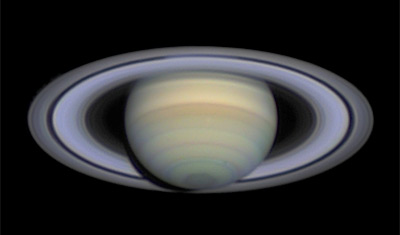Some daily sky sights among the ever-changing Moon, planets, and stars.
The nova in the Sagittarius Teapot continues to vary between about magnitude 4.5 and 6.5 nearly two months after it erupted. As of May 14th it was back down to about 6.3. Being a "slow nova," it could reach an even higher peak in the coming months as Sagittarius enters the evening sky. It's currently due south just before the beginning of dawn. See article with charts and a link to an up-to-date light curve.

Friday, May 8
The two brightest points in sky this spring are Venus and Jupiter. At dusk this week, they're in the west and high in the southwest respectively. Find the halfway point between them. A little upper right of there tonight is Pollux, with Castor to its right.
Saturday, May 9
Three zero-magnitude stars shine after dark in May: Arcturus very high in the southeast, Vega much lower in the northeast, and Capella in the northwest. They look so bright because each is at least 60 times as luminous as the Sun, and also because they're relatively nearby: 37, 25, and 42 light-years from us, respectively.
Sunday, May 10
Arcturus dominates the high southeast during evening. Three fists at arm's length to its lower right is Spica, less bright. Half that distance to the right or lower right of Spica is Corvus, the springtime Crow. Its four brightest stars form a sail shape.
Monday, May 11
Even in May, can you still see Cassiopeia? After dark, its broad, tilted W is way down at the north horizon directly below the Big Dipper's Pointers, which are almost overhead. But that's if you're in the mid-northern latitudes! If you're as far south as Jacksonville (30° N) part of Cassiopeia is below the horizon, and at Miami (26° N) nearly all of it is.
Last-quarter Moon (exact at 6:11 a.m. EDT on this date).
Tuesday, May 12
A small telescope will show Jupiter's moon Callisto gradually emerging from eclipse out of Jupiter's shadow around 11:52 p.m. EDT (8:52 p.m. PDT) — right next to Ganymede, the brightest of Jupiter's satellites. Io and Europa also happen to be nearby.
Wednesday, May 13
Summer is more than a month away, but the Summer Triangle is making its appearance in the east, one star after another. The first in view is Vega. It's already sparkling in the northeast as twilight fades. Next up is Deneb, lower left of Vega by two or three fists at arm's length. It's in view by the time nightfall is complete, depending on your latitude. The third is Altair, which shows up far to Vega's lower right after 11 p.m.

Thursday, May 14
Canes Venatici, the Hunting Dogs, floats near the zenith these evenings, inside the curl of the Big Dipper's handle. With the evening sky moonless, go galaxy hunting here with Sue French's Deep-Sky Wonders article and chart in the May Sky & Telescope, page 56.
Friday, May 15
Venus this evening shines smack between Capella 25° to its right and Procyon 25° to its left.
Saturday, May 16
Arcturus shines high in the southeast these nights. Vega shines much lower in the northeast. Look a third of the way from Arcturus to Vega for dim little Corona Borealis, the Northern Crown, with its one modestly bright star, Alphecca or Gemma. Two thirds of the way from Arcturus to Vega glimmers the dim Keystone of Hercules. Continue on down past Vega, and you hit Cygnus.
__________________________
Want to become a better astronomer? Learn your way around the constellations. They're the key to locating everything fainter and deeper to hunt with binoculars or a telescope.

Once you get a telescope, to put it to good use you'll need a detailed, large-scale sky atlas (set of charts). The standards are the little Pocket Sky Atlas, which shows stars to magnitude 7.6; the larger and deeper Sky Atlas 2000.0 (stars to magnitude 8.5); and once you know your way around, the even larger Uranometria 2000.0 (stars to magnitude 9.75). And read how to use sky charts with a telescope.
You'll also want a good deep-sky guidebook, such as Sue French's Deep-Sky Wonders collection (which includes its own charts), Sky Atlas 2000.0 Companion by Strong and Sinnott, the bigger Night Sky Observer's Guide by Kepple and Sanner, or the beloved if dated Burnham's Celestial Handbook.
Can a computerized telescope replace charts? Not for beginners, I don't think, and not on mounts and tripods that are less than top-quality mechanically (able to point with better than 0.2° repeatability, which means fairly heavy and expensive). As Terence Dickinson and Alan Dyer say in their Backyard Astronomer's Guide, "A full appreciation of the universe cannot come without developing the skills to find things in the sky and understanding how the sky works. This knowledge comes only by spending time under the stars with star maps in hand."
This Week's Planet Roundup


Mercury remains fairly well up in evening twilight this week, but it's fading fast: from magnitude +0.5 on May 8th to +1.7 on the 15th. That's a loss of another two-thirds of its brightness — after it lost half its brightness last week. Look for it far to the lower right of Venus.
Venus (magnitude –4.2, at the feet of Gemini) glares strikingly bright in the west during and after twilight — the "Evening Star." It doesn't set in the west-northwest until almost two hours after dark. In a telescope Venus is still slightly gibbous but is approaching dichotomy: "half-moon" phase.
Mars is lost in the sunset.
Jupiter (magnitude –2.0, in Cancer) shines high in the southwest as the stars come out; less high in the west later. It's the second-brightest point of light in the sky after Venus. These two planets are closing in toward each other: from 43° apart on May 8th to 35° apart on the 15th. They'll have a spectacularly close conjunction at the end of June.
Saturn (magnitude +0.1, just above the head of Scorpius) rises in twilight and reaches its highest point in the south around 1 or 2 a.m. It's nearing its May 22nd opposition. Below Saturn by 9° or 10° by very late evening is twinklier, orange Antares, less bright.
Uranus (magnitude +5.9, in Pisces) is just above the eastern horizon as dawn begins to brighten.
Neptune (magnitude +7.9, in Aquarius) is low in the east-southeast before the first light of dawn.
__________________________
All descriptions that relate to your horizon — including the words up, down, right, and left — are written for the world's mid-northern latitudes. Descriptions that also depend on longitude (mainly Moon positions) are for North America.
Eastern Daylight Time (EDT) is Universal Time (UT, UTC, or GMT) minus 4 hours.
__________________________
“This adventure is made possible by generations of searchers strictly adhering to a simple set of rules. Test ideas by experiments and observations. Build on those ideas that pass the test. Reject the ones that fail. Follow the evidence wherever it leads, and question everything. Accept these terms, and the cosmos is yours.”
— Neil deGrasse Tyson, 2014.
 0
0
Comments
You must be logged in to post a comment.